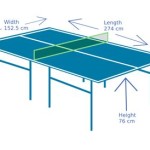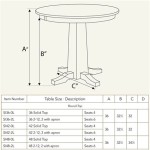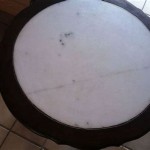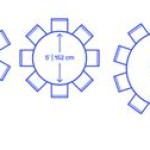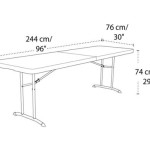Plans To Build a Sewing Machine Table
The construction of a dedicated sewing machine table can significantly enhance the sewing experience. A well-designed table provides a stable and ergonomic workspace, allowing for smoother fabric handling and reduced strain during extended sewing sessions. Plans for building a sewing machine table range from simple, beginner-friendly designs to more complex, feature-rich options. The choice of design depends on the individual's woodworking skills, available space, budget, and desired functionalities.
Before embarking on the construction process, careful consideration should be given to the specific sewing machine model. Dimensions and weight are crucial factors that will influence the table's size and structural requirements. Additionally, the intended use of the table, such as for quilting or garment construction, will affect the desired surface area and features.
This article will explore key considerations and design elements involved in planning and executing the construction of a sewing machine table, offering insights into material selection, essential tools, and different design approaches.
Key Point 1: Essential Considerations Before Building
Prior to initiating the construction of a sewing machine table, a thorough assessment of several factors is necessary. This pre-construction planning phase ensures that the final product meets the individual's specific needs and avoids potential complications during the building process.
The first and perhaps most important consideration is the dimensions of the sewing machine. The length, width, and height of the machine dictate the minimum size of the table's surface. It is crucial to allow for additional space around the machine to accommodate fabric manipulation during sewing. A recessed platform, specifically designed to house the sewing machine bed flush with the table surface, is a common feature that enhances comfort and usability. The dimensions of this recessed area must be accurately measured to ensure a snug and secure fit.
Ergonomics is another critical aspect. The height of the table should be adjusted to the individual's stature to prevent back and shoulder strain. Ideally, the sewing machine bed should be at a comfortable working height, allowing the user to maintain a relaxed posture. Adjustable legs or risers can be incorporated into the design to provide flexibility in height adjustment.
Storage requirements should also be considered. Sewing projects often involve numerous accessories, such as thread spools, bobbins, scissors, seam rippers, and measuring tapes. Incorporating drawers, shelves, or cabinets into the table design can provide convenient storage solutions, keeping these essential tools within easy reach. The size and configuration of these storage compartments should be tailored to the individual's specific needs and the available space.
The available space in the sewing area plays a significant role in determining the overall size and design of the table. A small workspace may necessitate a compact, foldable table, while a larger area can accommodate a more substantial and feature-rich design. The table's mobility should also be considered. If the table needs to be moved frequently, casters or wheels can be added to facilitate easy relocation. However, it is important to ensure that the casters are lockable to prevent unwanted movement during sewing.
Finally, the budget should be carefully considered. The cost of materials, hardware, and finishing products can vary significantly depending on the chosen design and quality. It is advisable to create a detailed budget outlining the estimated cost of each component before starting the project. This will help prevent unexpected expenses and ensure that the project remains within the allocated financial constraints.
Key Point 2: Material Selection and Construction Techniques
The choice of materials and construction techniques significantly impacts the durability, aesthetics, and overall functionality of the sewing machine table. Careful selection of materials and adherence to sound construction practices are essential for creating a sturdy and long-lasting table.
Hardwood lumber, such as maple, oak, or cherry, is a popular choice for sewing machine tables due to its strength, stability, and aesthetic appeal. These woods are relatively durable and resistant to wear and tear. However, hardwood can be more expensive and requires more specialized tools for cutting and shaping. Softwood lumber, such as pine or fir, is a more affordable option, but it is less durable and prone to scratches and dents. Softwood is generally easier to work with and can be a suitable choice for simpler designs or for projects where cost is a primary concern.
Plywood is another versatile material that can be used in sewing machine table construction. Plywood is made from multiple layers of wood veneer glued together, which provides excellent strength and stability. It is less susceptible to warping and cracking than solid wood and can be easily cut and shaped. Plywood is often used for the table's top surface, shelves, and cabinet doors. When using plywood, it is important to choose a high-quality grade with a smooth, sanded surface to ensure a professional finish.
The joinery techniques used to assemble the table components are crucial for ensuring its structural integrity. Common joinery methods include screws, dowels, pocket-hole joinery, and mortise and tenon joints. Screws are the simplest and most common method, but they may not be as strong as other joinery techniques. Dowels provide a stronger connection and can be used to reinforce joints. Pocket-hole joinery is a relatively quick and easy method that creates strong and concealed joints. Mortise and tenon joints are the strongest and most durable, but they require more skill and precision to execute.
The finishing process is essential for protecting the table from moisture and wear and for enhancing its aesthetic appeal. Sanding the wood surfaces smooth is the first step. This removes any imperfections and creates a smooth surface for the finish to adhere to. A wood sealant or primer can be applied to prevent the finish from being absorbed into the wood and to create a more uniform color. The choice of finish depends on the desired look and level of protection. Polyurethane is a durable and water-resistant finish that is suitable for high-use surfaces. Varnish provides a more traditional look and offers good protection. Paint can be used to create a colorful and customized finish. Regardless of the chosen finish, it is important to apply multiple coats and allow each coat to dry completely before applying the next.
Key Point 3: Design Variations and Features
The design of a sewing machine table can be tailored to meet a wide range of individual needs and preferences. Numerous design variations and features can be incorporated to enhance the table's functionality, ergonomics, and aesthetics.
A drop-leaf extension can be added to the table to provide additional workspace when needed. The drop-leaf can be hinged to the main table surface and supported by folding brackets or legs. When not in use, the drop-leaf can be folded down to save space. This feature is particularly useful for larger projects, such as quilting or garment construction.
A built-in thread rack can be incorporated into the table design to provide convenient storage for thread spools. The thread rack can be mounted on the side of the table or integrated into a drawer or cabinet. The rack should be designed to accommodate a variety of thread spool sizes and to keep the spools organized and easily accessible.
A cutting mat can be recessed into the table surface to provide a dedicated area for cutting fabric. The recessed area should be slightly larger than the cutting mat to allow for easy removal and replacement. This feature eliminates the need for a separate cutting table and helps to keep the workspace organized.
An adjustable sewing machine platform can be incorporated into the table design to allow for fine-tuning of the sewing machine's height. The platform can be raised or lowered to achieve the optimal ergonomic position. This feature is particularly useful for individuals who use different sewing machines or who have varying height requirements.
A knee lift mechanism can be added to the table to allow for hands-free control of the presser foot. The knee lift mechanism is typically operated by a lever that is positioned under the table. This feature allows the sewer to keep both hands on the fabric while raising and lowering the presser foot, which can improve accuracy and efficiency.
In conclusion, careful planning, material selection, and construction techniques are essential for building a functional and aesthetically pleasing sewing machine table. By considering the individual's needs and preferences, a customized table can be created to enhance the sewing experience and improve productivity.

Quiltfabrication Patterns And Tutorials Diy Sewing Table

Diy Sewing Machine Table Dadand Com

Busy Bee No 16 Make Your Own Sewing Machine Cabinet Table Diy Room Design

Craft Room Sewing Table Tutorial Decor And The Dog

Folding Sewing Table Ana White
:max_bytes(150000):strip_icc()/noodlehead-02f40a2748a8482c9faa7862011d1b47.jpg?strip=all)
10 Free Diy Sewing Table Plans

Making A Custom Sewing Machine Extension Table Tutorial Quilting Jetgirl

25 Homemade Diy Sewing Table Plans And Ideas

25 Homemade Diy Sewing Table Plans And Ideas

Diy Sewing Machine Table


